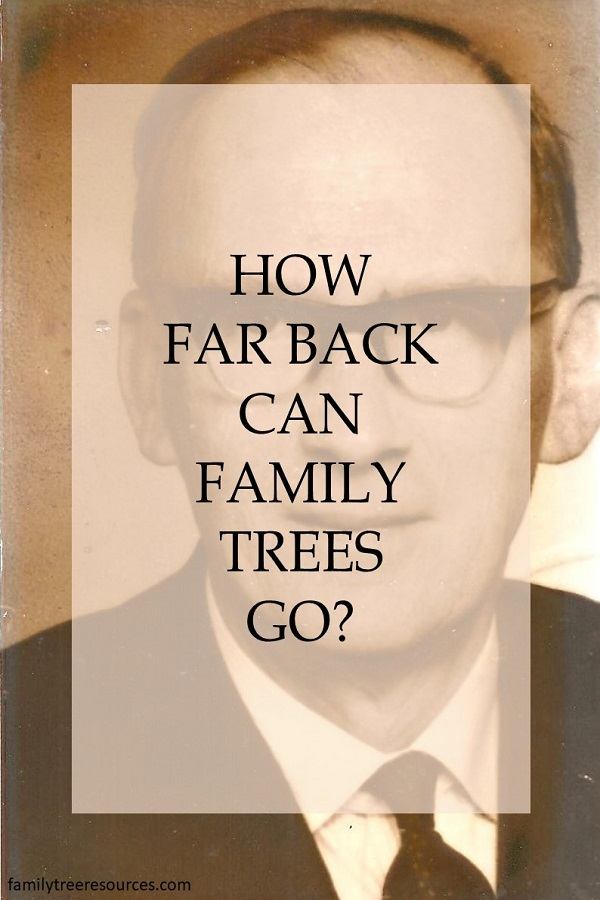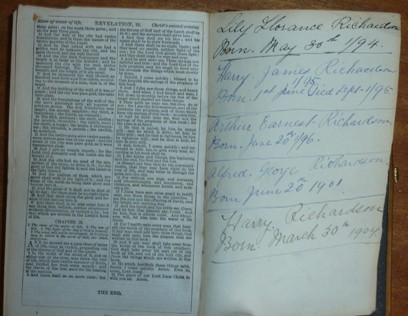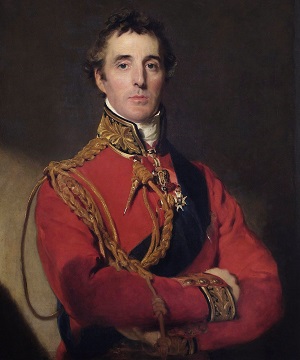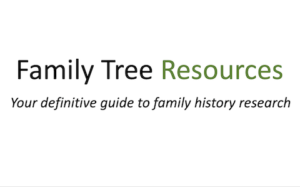
It can be relatively straightforward to trace your family tree back to 1837, when public records such as birth, marriage and death certificates and Census Returns (1841) became available, but it can be more difficult to trace further back because of the availability of the records.
Most people can trace some of their lineage back to the 1700s or beyond, but how far back family trees can go depends on the availability of the records, how common the surname is and the family’s social status.
As long as the records are available, it is completely up to you to decide how far back in time you would like to trace your family tree. You may decide to only trace your grandparents and great-grandparents or attempt to trace back to the 1700s and beyond.
Tracing Your Family Tree After 1837
It can be straightforward to trace your family tree back to when public records began in 1837, with documents such as birth, marriage and death certificates and census returns being readily available.
As the GRO have made birth and death indexes up to 1918 and 1957 respectively available online, and Census Returns are available on pay-to-view sites such as FindmyPast, Ancestry and The Genealogist, and free sites such as FreeCen, you may be able to trace your family tree back to 1837 without leaving the house.
There are still obstacles you may have to overcome if you wish to trace your family tree back to this date, however.
If your ancestor had a more common name, you may have to order birth, death and marriage certificates to ensure that you have found the correct person in the index, which can become very expensive.
Prior to 1875, registering births, marriages and deaths was not compulsory, so you may find that no record exists for your ancestor, which can make it that much more difficult to trace them.
It can be easier to trace back a family tree if your ancestor had a relatively unusual name such as Leonard Cecil Dallington, and you have a good idea of his age and place of birth.
If, on the other hand, your ancestor was John Smith, and you only know he was born in London circa 1856, it can make tracing him that much more difficult.
I have found this to be true with one particular line; I have been trying, without success, to trace Mary Ann Minton, my ancestor, for years, but have yet to find her birth record. As far as I am aware, she had at least three different surnames – Packer, Pecker, and Minton – this does not make it easy to ascertain what her birth surname actually was!!!
You may find that an entire family were not at their residence at the time of a particular census. In these cases, it is prudent to look at a later census to see if the family were recorded.
Some census returns are missing, or are illegible, so this could be another reason why you are unable to find your ancestor and his family on a particular census.
Family Bibles Can Help Take Your Family Tree Further Back
Another document which may be of use when you are tracing your ancestry is a family bible, which may provide information about the family because the owner’s marriage and children’s birth dates may have been added to the book.

Tracing Your Family Tree Prior to 1837
It becomes more complicated if you have managed to trace your family tree back to before 1837.
Before the advent of civil registration, one of the only ways of tracing your family tree further back is to use parish registers, which, depending on where you are searching, can provide plenty of information regarding your ancestor, especially from the late 18th century onwards.
Parish Registers are usually kept in record offices, but can also still be kept by the church, so you have to discover where the registers you are interested in are kept. Some parish registers are also being made available online.
Going further back to the 15th, 16th centuries and 17th centuries can become more difficult because there is an increased chance that more registers will be damaged or missing altogether, especially in the Commonwealth period between 1649 and 1660.
In earlier centuries, the writing in the registers and other records can become increasingly difficult to read.
If your ancestor was an average person, it may become impossible to trace them any further back because there are no records so there is no way of proving the connection, even if you suspect you know the parentage.
In some areas, parish registers go further back than others – in Northamptonshire, Roade registers began in 1587, but in Potterspury they only go back to 1666.
Do not discount wills if you are unable to trace your ancestors in parish or nonconformist registers. I could not trace the parentage of my ancestor Eleanor Scrivener who was born in Potterspury in approximately 1769 because the registers of the independent church in Potterspury were missing during this period, meaning I could not locate her baptism record.
I suspected her father was Joseph Scrivener, who died in 1808, but was unable to prove it. Looking at his will, however, proved in the Prerogative Court of Canterbury, listed all his children, including Eleanor!! I had finally tracked down by elusive ancestor and was thus able to continue my research.
Illegitimacy Can Make It Hard to Take Your Family Tree Further Back
It is possible that you will find that one or more of your ancestors was illegitimate, which can make tracing the father more difficult unless he was named in the register or was mentioned in another medium such as bastardy bonds or newspapers.
I have recently been able to ascertain the parentage of my ancestor Jane McJannett, who was born in Narborough, Leicestershire in 1845. Although her birth certificate only stated the name of her mother, Ann McJannett (Jannett), a report in the Leicestershire Mercury (30 August 1845) stated that she had affiliated an illegitimate child upon John Shingler of Boughton, Leicestershire.
Ancestors Movements May Make It Hard to Track Down Birth Place
If your ancestor moved from one place to another, you may never be able to discover where he came from, especially if he moved from one county to another.
My ancestor, Michael Bradford, and his wife Elizabeth, had children baptised in Wilby, Northamptonshire between 1695 and 1699, but I am unable to find their marriage in Wilby, nor the baptism of their son John who was buried in Wilby.
I suspect he was born outside the county, but so far have been unable to trace him. I have also been unable to trace Michael’s marriage to Elizabeth, so am unable to determine what her surname was.
My Ancestors were Nonconformists
Some individuals did not attend church, even though attendance was compulsory in the 16th and 17th centuries, which lead to the rise of nonconformity. If your ancestors were nonconformists, this can present an additional challenge because the records are not so readily available.
You may find, like I did when I was perusing the registers for Potterspury and Yardley Gobion Independent, that some years are missing altogether and you have to peruse other records to take your family tree further back.
Tracing Your Family History in Wales
Many families in Wales share the same surname. 50% of families in Wales share one in ten surnames, with fixed surnames not being adopted until the 18th century. This makes it that much more difficult to ensure you have found the correct person.
What If My Family Originated From a Different Area?
If your family originated from a different area to where you live, the cost of research could become prohibitive because you have to factor in the cost of travelling to the area’s Record Office.
Tracing Women in Your Family Tree
The further back you go, the harder it becomes to trace your female ancestors because they were not considered important enough to be mentioned in parish registers and other documents.
If you are searching for your ancestor’s baptism, especially in earlier years, it may only mention the name of the father and not mention the mother at all.
If a woman was widowed and had died, the burial record may simply state Widow Dunkley, and give no further information, making it impossible to determine if you have found the entry for the correct person.
Was Your Ancestor a Member of the Upper Class?
If your ancestor was wealthy enough to purchase land, you may find that deeds contain much more information about the family. Pedigrees of landowning families have normally been recorded from the 15th century onwards.

If your ancestor was a member of the gentry, their ancestry may have already been recorded. Pedigrees of several families are listed in A Genealogical and Heraldic History of the Colonial Gentry.
Another option is to see if your ancestor has been listed in books such as Burke’s Peerage, making it that much easier to trace them further back.
Tracing Ancestry Back to Adam
Pedigrees that claim to be able to trace their family tree back to Adam and Eve generally have no real proof of where the information originated, so you have no way of knowing how reliable such pedigrees are.
There are many problems that you must bear in mind when perusing such pedigrees, which include:
- Family surnames, as we know them, did not begin to be recorded until the middle of the eleventh century, and were not always recorded even after that date. Many names were repeated, making it that much more difficult to ascertain which one would have been our ancestor.
- Many lines claiming to go back to Adam have ‘traced’ their lineage back to King David, which to them is definitive proof of the connection to Adam because Kings had a divine right to rule because they were placed on the throne by God.
- Another problem is the lack of any written documentation. Authentic documents do not exist for that period because they were not made in earlier centuries. Family stories were generally passed orally from one generation to the next, later being transcribed by scribes, which are considered to be quite accurate, but again it is hard to find real proof because these were transcribed from stories which could easily have been fabrications. Truth was often bent to serve political and economic objectives.
